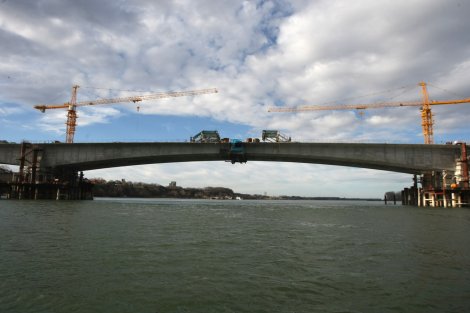On 15th December, the Chinese Prime Minister Li Keqiang shook hands with his Serbian counterpart opening a transit bridge that is to connect two, up to that point, divided sides of Belgrade. The bridge built by the joint effort of the Chinese and Serbian construction workers, engineers and architects, costs 226 million US Dollars. It was one the largest Chinese investments in Eastern Europe until only recently. In fact, when first announced, this project was the largest Chinese infrastructural investment in Europe as a whole.
The entire ceremony took place as a part of a two day meeting, named China and Central Eastern Europe Summit. The idea behind the event was to further foster Chinese investment and political engagement in Europe, particularly in its Central and Eastern part. Serbia featured as a host, trying to present itself, like many times before, as a bridge between the East and the West. The summit created an opportunity for many high level discussions, yet results of these discussions are yet to be seen. Right now, there are probably three most important lessons one could learn from this event.
Firstly, the summit served as a clear signal of Chinese further investment, both political and economic, into Europe. This comes as no surprise, since China is to this day the second largest EU trade partner, being surpassed only by the United States. The level of trade between the two reaches EUR 1 Billion a day, making it the largest level of trade in the world. Chinese entrance into the Eastern and Central European markets comes as no surprise, given that this economic giant will try to find new ways to promote its investment and infrastructural capacities, as well as offer opportunities for its businesses.
Secondly, the summit offered a great opening for Serbian government to position itself away from the Russian shadow. After a recent military parade held in honor of the Soviet liberation of Belgrade, as well as an almost religious refusal to join the EU sanctions towards Russia, Serbia has started to find itself further on the Putin’s bloc than what was primarily thought of this EU candidate state. Pressured by internal struggles, the Serbian government capitalized upon the summit offering its citizens even more promises, this time backed by external figures, ones that could not be criticized so easily. It also offered Serbian government a way out of their unplanned energetic and economic crisis caused by the premature cancellation of the Southern Stream project, and Russia’s shift to Near Eastern markets.
Finally, the summit sparked a breath of fresh air into the Eastern Europe. Burdened by its communist past, the Eastern European countries are yet to catch up with their Western neighbors in terms of economic indicators. Chinese capital injections just might seem as the right choice for the still recovering Eastern and Central European economies. The reassurance that all of the infrastructural plans will be undertaken in accordance with the EU law also helps ease the pressure of the EE states looking to develop quickly and efficiently.
The three lessons learned paint a very interesting picture of region’s future. What they also do is show how well positioned China is at the moment, and how well prepared they are to use that position.
Russia’s perilous economic situation may as well serve as a red flag for many European companies, as well as governments. Burdened by sanctions from both the EU and the US, combined by the price of oil reaching all time lows, Russian economy is nearing its collapse, with ruble losing more than 50% of its value to US dollar. In this atmosphere, Russia is starting to lose its potential as a legitimate trade and investment partner for Europe. In fact, according to Eurostat, only one month after the sanctions were imposed, the exports to Russia fell by 19% to mere 7.9 Billion €, which when compared to a month before the sanctions signals a loss of more than 2 Billion €.
Since it is clear that Russia’s situation cannot suddenly become better, nor that its foreign policy could change substantially, the Chinese slow yet sure entrance to the European market comes as godsend. The now officially largest economy of the world is prepared to invest more than 8 billion € in the Balkans alone, offering either loans or FDI for multiple telecommunication and infrastructural projects. Although this lump of money is yet to be seen, China is sending a clear message to the Balkans, and the entire Eastern Europe that they have a new partner.
China is also using this situation to establish its footing in Europe, as well as to boost its economy. Many of the discussed projects, just like the ones before them, are supposed to be funded through China’s state bank loans. It is expected that the Chinese companies are to be hired in order to do work on these projects as well. Finally, although Chinese officials have agreed to follow EU legislation, it should not be taken out of sight that the large part of the Balkans is still outside of the EU, therefore, certain shortcuts might be taken.
As for the Balkans, and the entire region of Eastern and Central Europe, this type of investment looks very attractive. The entire region, although a large portion of it being a part of the European Union, still had very strong economic ties with Russia. The sanctions that hit Putin’s regime have invariably caused harm to many Eastern and Central European economies. Having a new foreign partner is a great opportunity, one that Eastern and Central European countries could not wait for. A good example of this is a EUR 2 Billion fast railway track project that has been agreed at the summit. The railway is supposed to run from Belgrade to Budapest, facilitating trade routes in Europe, as well as being a first step to connecting Piraeus with the rest of the EU through a fast and a reliable connection.
In this type of a constellation, it seems that Russia is the only one to lose. With the ruble going down and price of oil declining without a stop, it looks as if Russia is starting to lose what little political and economic importance in the Eastern and Central Europe it had. The Chinese investments, although carrying zero sentimental value, do seem much more plausible and efficient. Furthermore, European Union has a much lower level of coercion with the Chinese foreign policy, which as a result offers a much more breathable cooperation atmosphere for all of the parties invested in these agreements. It might just seem that this dance is simply made for two, and Russia should find a new partner.














Leave a Comment
Your email address will not be published. Required fields are marked with *